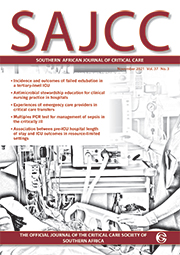Guideline

The Critical Care Society of Southern Africa Consensus Guideline on ICU Triage and Rationing (ConICTri)
Abstract
Background. In South Africa (SA), administrators and intensive care practitioners are faced with the challenge of resource scarcity as well as an increasing demand for intensive care unit (ICU) services. ICU services are expensive, and practitioners in low- to middle-income countries experience the consequences of limited resources daily. Critically limited resources necessitate that rationing and triage (prioritisation) decisions are routinely necessary in SA, particularly in the publicly funded health sector.
Purpose. The purpose of this guideline is to utilise the relevant recommendations of the associated consensus meeting document and other internationally accepted principles to develop a guideline to inform frontline triage policy and ensure the best utilisation of adult intensive care in SA, while maintaining the fair distribution of available resources.
Recommendations. An overall conceptual framework for the triage process was developed. The components of the framework were developed on the basis that patients should be admitted preferentially when the likely incremental medical benefit derived from ICU admission justifies admission. An estimate of likely resource use should also form part of the triage decision, with those patients requiring relatively less resources to achieve substantial benefit receiving priority for admission. Thus, the triage system should maximise the benefits obtained from ICU resources available for the community. Where possible, practical examples of what the consensus group agreed would be considered appropriate practice under specified South African circumstances were provided, to assist clinicians with practical decision-making. It must be stressed that this guideline is not intended to be prescriptive for individual hospital or regional practice, and hospitals and regions are encouraged to develop specified local guidelines with locally relevant examples. The guideline should be reviewed and revised if appropriate within 5 years.
Conclusion. In recognition of the absolute need to limit patient access to ICU because of the lack of sufficient intensive care resources in public hospitals, this guideline has been developed to guide policy-making and assist frontline triage decision-making in SA. This document is not a complete plan for quality practice, but rather a template to support frontline clinicians, guide administrators and inform the public regarding appropriate triage decision-making.
Authors' affiliations
G M Joynt, Department of Anaesthesia and Intensive Care, The Chinese University of Hong Kong, Hong Kong
D P Gopalan, Department of Anaesthesiology and Critical Care, School of Clinical Medicine, University of KwaZulu-Natal, Durban, South Africa
A A Argent, Department of Paediatrics and Child Health, University of Cape Town, South Africa
S Chetty, Department of Anaesthesiology and Critical Care, Stellenbosch University, Cape Town, South Africa
R Wise, Department of Anaesthesiology and Critical Care, School of Clinical Medicine, University of KwaZulu-Natal, Durban, and Edendale Hospital, Pietermaritzburg, South Africa
V K W Lai, Department of Anaesthesia and Intensive Care, The Chinese University of Hong Kong, Hong Kong
E Hodgson, Department of Anaesthesiology and Critical Care, School of Clinical Medicine, University of KwaZulu-Natal, Durban, and Inkosi Albert Luthuli Central Hospital, Durban, South Africa
A Lee, Department of Anaesthesia and Intensive Care, The Chinese University of Hong Kong, Hong Kong
I Joubert, Department of Anaesthesia and Peri-operative Medicine, University of Cape Town and Groote Schuur Hospital, Cape Town, South Africa
S Mokgokong, Department of Neurosurgery, University of Pretoria, South Africa
S Tshukutsoane, Chris Hani Baragwanath Academic Hospital, Soweto, Johannesburg, South Africa
G Richards, Department of Critical Care, Faculty of Health Sciences, University of the Witwatersrand, Johannesburg, South Africa
C Menezes, Chris Hani Baragwanath Academic Hospital, Soweto, Johannesburg, South Africa;Department of Internal Medicine, Faculty of Health Sciences, University of the Witwatersrand, Johannesburg, South Africa
R L Mathivha, Department of Critical Care, Faculty of Health Sciences, University of the Witwatersrand, Johannesburg, South Africa
B Espen, Centre for Health Professions Education, Stellenbosch University, Cape Town, South Africa
B Levy, Netcare Rosebank Hospital, Johannesburg, South Africa
K Asante, African Organization for Research and Training in Cancer, Cape Town, South Africa
F Paruk, Department of Critical Care, University of Pretoria, South Africa
Cite this article
Article History
Date published: 2019-08-22
Article Views
Full text views: 3786




1.jpg)
Comments on this article
*Read our policy for posting comments here